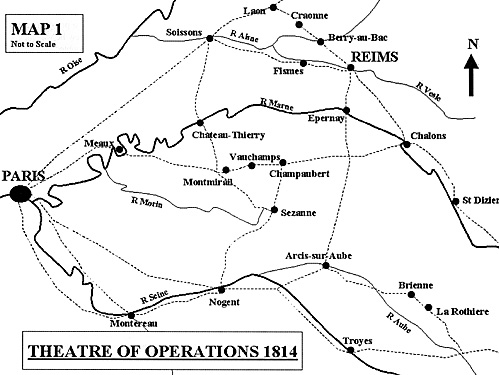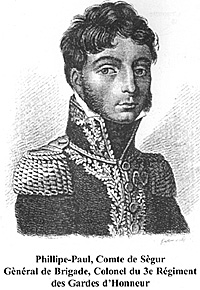The Gardes d'Honneur and
Charge of the 3rd Regt
at Reims, 13th March 1814
Gardes d'Honneur 1813-1814
by Andrew Field
| |
On the 7th March, when the division was sent to the support of Reims, it numbered only 800 men. According to de Ségur this was due to two hundred detachments and the lack of remounts for the many Gardes who had lost their horses through wounds, sickness or neglect; they were infamous for not looking after their mounts! Phillipe-Paul, Comte de Sègur Gènéral de Brigade, Colonel du 3e Régiment des Gardes d’Honneur During their short stay in Reims stragglers and detachments coming in took the total up to 1,000. At this time we know that the 10th Hussars numbered 500 men and the 1st Regiment only 130, thus leaving the 3rd and 4th Regiments with a total of 370 between them present for duty! When St Priest approached the city again on the 11th Mar, having been reinforced, the division left the garrison, to which they were only attached, in order to avoid being blockaded and taken. Withdrawing to the West and unsure of the fate of the Emperor who was facing disaster after Laon, the senior commanders of the division discussed operating as partisans on the enemy’s communications. It was while they were in this state of uncertainty that they met up with Marshal Marmont’s VI Corps. After their rout at Laon, this corps had collected at Fismes, between Soissons and Reims. The lack of pursuit had allowed Marmont the vital time he needed to reform and reorganise his troops and it is to their credit that such a short time after this debacle they were again ready for combat. The VI Corps, Bordesoulle’s I Cavalry Corps and Defrance’s division were to be the advance guard of Napoleon’s push on Reims. Behind them the Emperor rode with Ney’s small corps, the three divisions of Guard Cavalry and Friant’s division of the Old Guard, a total of about 15,500 infantry and 8,300 cavalry. St Priest and his 14,500 men were blissfully unaware of the storm that was about to break upon them. Completely reassured by the confident announcements of the destruction of the French army, the Russians and Prussians were taken completely by surprise. Whilst the Russians were accommodated inside the city, the Prussians had been sent out to some of the outlying villages between it and Napoleon’s advance. Reports of the French advance from the cavalry outposts were dismissed as parties of stragglers. The French cavalry by-passed two battalions of Prussian landwehr in order to push on; after initial resistance these battalions surrendered to Marmont’s infantry. Finally convinced about the strength of the French advance, St Priest hurriedly sent his troops forward of the city to occupy the heights of St-Geneviève. Napoleon had hoped to outflank this line to the north with the aim of not only turning their defensive position but also cutting them off from any help from Blücher’s forces in this direction. Unfortunately St Priest’s line was anchored on the River Vesle across which all the bridges had been destroyed. Whilst one of these was repaired Napoleon therefore ordered a frontal assault. Although St Priest occupied what was superficially quite a strong position, it had one significant weakness: the withdrawal route took it through a double defile. First it had to cross a bridge over the Vesle and then it had to enter the city. Whilst this was not a problem against a weak and disorganized force, once he knew he was facing Napoleon himself, St Priest must have doubted the wisdom of his choice. Marmont’s infantry occupied the Ormes plateau overlooking the city and watched the deployment of the Prussians and Russians. Defrance’s division, occupying the valley of the Muire, faced the Russian cavalry, which covered the southern flank of the allied line. An early encounter between this cavalry and Picquet’s first brigade resulted in Picquet being wounded and his brigade pushed back with heavy casualties. The second brigade (de Ségur) was sent to his support and the afternoon settled down into a hot, if indecisive, skirmish. De Ségur’s memoirs tell of Brigadier Boussman, an experienced and courageous member of the 3rd Regiment, who several times rode through gaps in the Russian cavalry line, fired his pistols into the rear of the Russians and then rode back “unhurried” and without being challenged! Map 
More Gardes d'Honneur
Gardes d'Honneur 1813-1814 The Situation at Reims The Charge of the 3rd Gardes d'Honneur Back to Table of Contents -- First Empire #62 Back to First Empire List of Issues Back to MagWeb Master Magazine List © Copyright 2002 by First Empire. This article appears in MagWeb (Magazine Web) on the Internet World Wide Web. Other military history articles and gaming articles are available at http://www.magweb.com |
